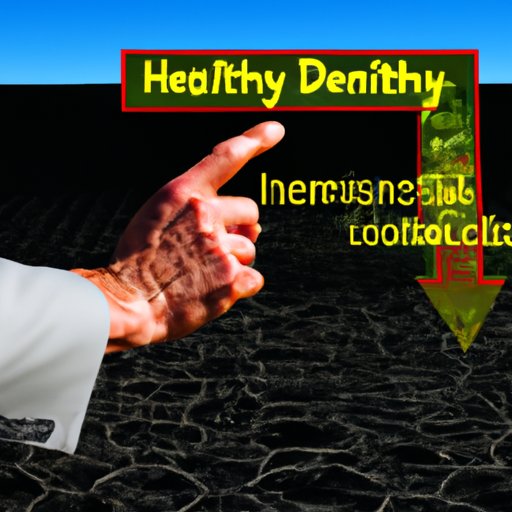Introduction
Health is an important part of our lives. It affects every aspect of our lives, from our physical well being to our mental and social wellbeing. As such, understanding the different health dimensions is essential in order to maintain a healthy lifestyle. This article will explore the definition of health dimensions, provide an overview of the problem, and examine the different dimensions of health.

Exploring the Different Dimensions of Health
Health dimensions can be broadly divided into three main categories: physical health, mental health, and social health. Each of these categories has its own set of factors that contribute to overall health and wellbeing. Let’s take a closer look at each of these categories.
Physical Health Dimension
The physical health dimension includes factors such as nutrition, exercise, sleep, and other elements related to physical health. Eating a balanced diet, exercising regularly, and getting enough sleep are all important for maintaining physical health. Without these elements, it becomes difficult to maintain a healthy lifestyle.
Mental Health Dimension
The mental health dimension includes cognitive skills, emotional wellbeing, and social interactions. Cognitive skills refer to our ability to think, reason, and remember. Emotional wellbeing refers to our ability to manage our emotions and cope with stress. Social interactions refer to our ability to connect with others and build relationships.
Social Health Dimension
The social health dimension includes social support, access to resources, and cultural participation. Social support refers to having people who care about us and provide us with emotional and practical assistance. Access to resources refers to having access to basic needs such as food, housing, and healthcare. Cultural participation refers to engaging in activities that are meaningful to us and that bring us joy.
What Are the Key Dimensions of Health?
In order to understand the different health dimensions, it is important to consider the key elements that contribute to health. These include biological factors, behavioral factors, and environmental factors.
Biological Factors
Biological factors refer to our genetic makeup, which determines our physical characteristics and predisposition to certain illnesses. Biological factors also include hormones, which influence our physical and mental health.
Behavioral Factors
Behavioral factors refer to our habits and behaviors, which can either have a positive or negative effect on our health. Examples of behavioral factors include diet, exercise, drug use, and smoking.
Environmental Factors
Environmental factors refer to the environment in which we live, which can have a significant impact on our health. Examples of environmental factors include air pollution, water quality, and access to safe and healthy food.
An Overview of Physical, Mental, and Social Health Dimensions
Let’s take a closer look at the physical, mental, and social health dimensions and how they are interconnected.
Physical Health Dimension
The physical health dimension includes several important components: nutrition, exercise, and sleep.
Nutrition – Eating a balanced diet is essential for maintaining physical health. Eating a variety of foods from the five food groups helps ensure that the body gets the nutrients it needs to stay healthy.
Exercise – Regular exercise helps to improve physical health by strengthening the heart and lungs, increasing muscle strength and flexibility, and improving balance and coordination.
Sleep – Getting adequate sleep is essential for physical health. Poor sleep can lead to fatigue and difficulty concentrating, as well as increased risk of illness.
Mental Health Dimension
The mental health dimension includes cognitive skills, emotional wellbeing, and social interactions.
Cognitive Skills – Cognitive skills refer to our ability to think, reason, and remember. Improving cognitive skills can help to improve overall mental health.
Emotional Wellbeing – Emotional wellbeing refers to our ability to manage our emotions and cope with stress. Developing healthy strategies for dealing with stress can help to improve emotional wellbeing.
Social Interactions – Social interactions refer to our ability to connect with others and build relationships. Engaging in meaningful relationships can help to improve mental health.
Social Health Dimension
The social health dimension includes social support, access to resources, and cultural participation.
Social Support – Social support refers to having people who care about us and provide us with emotional and practical assistance. Having a supportive network of family and friends can help to improve social health.
Access to Resources – Access to resources refers to having access to basic needs such as food, housing, and healthcare. Having access to these resources can help to improve social health.
Cultural Participation – Cultural participation refers to engaging in activities that are meaningful to us and that bring us joy. Participating in cultural activities can help to improve social health.
Understanding the Interconnectedness of the Health Dimensions
It is important to understand that the different health dimensions are interconnected. Our physical health can affect our mental health, and vice versa. Similarly, our social health can affect both our physical and mental health. Let’s take a closer look at how these dimensions interact with each other.
How Physical Health Affects Mental Health
Poor physical health can lead to a decrease in mental health. For example, inadequate nutrition can lead to low energy levels and fatigue, which can negatively affect our mood and cognitive functioning. Similarly, poor sleep can lead to irritability and difficulty concentrating.
How Mental Health Affects Physical Health
Poor mental health can lead to a decrease in physical health. For example, depression and anxiety can lead to changes in appetite and sleep patterns, which can lead to increased risk of illness. Similarly, chronic stress can weaken the immune system, making us more susceptible to illness.
How Social Health Affects Mental and Physical Health
Poor social health can lead to a decrease in both mental and physical health. For example, feeling isolated and alone can lead to feelings of sadness and depression, which can lead to physical symptoms such as headaches and stomachaches. Similarly, not having access to necessary resources can lead to increased stress and risk of illness.
Examining the Impact of Health Dimensions on Quality of Life
The health dimensions can have a significant impact on our overall quality of life. Let’s take a closer look at how physical, mental, and social health can affect our quality of life.
Physical Health and Quality of Life
Good physical health is essential for a high quality of life. Poor physical health can lead to decreased energy levels, difficulty performing daily activities, and increased risk of illness. Maintaining good physical health can help to improve overall quality of life.
Mental Health and Quality of Life
Good mental health is essential for a high quality of life. Poor mental health can lead to difficulty concentrating, increased risk of illness, and difficulty managing stress. Maintaining good mental health can help to improve overall quality of life.
Social Health and Quality of Life
Good social health is essential for a high quality of life. Poor social health can lead to feelings of isolation, decreased access to resources, and decreased engagement in meaningful activities. Maintaining good social health can help to improve overall quality of life.

Analyzing the Complexity of the Health Dimensions
It is important to understand that the different health dimensions are complex and interconnected. Genetics, environment, and behavior all play a role in determining our overall health.
The Role of Genetics
Genetics plays a significant role in determining our overall health. Our genes determine our physical characteristics and can predispose us to certain illnesses. Therefore, it is important to understand our family history and be aware of any potential health risks.
The Role of Environment
The environment in which we live can have a significant impact on our health. Exposure to air pollution, water pollution, and other environmental hazards can increase our risk of illness. Therefore, it is important to be aware of potential environmental hazards and take steps to reduce our exposure.
The Role of Behavior
Our behaviors can also have a significant impact on our health. Eating a balanced diet, exercising regularly, and getting enough sleep are all important for maintaining good health. Therefore, it is important to make healthy lifestyle choices in order to maintain good health.

Investigating How to Improve Health Through the Dimensions
Now that we have explored the different health dimensions, let’s take a look at how we can improve our health through these dimensions.
Improving Physical Health
In order to improve physical health, it is important to focus on nutrition, exercise, and sleep. Eating a balanced diet, exercising regularly, and getting enough sleep are all important for maintaining good physical health. Additionally, avoiding unhealthy behaviors such as smoking and excessive alcohol consumption can help to improve physical health.
Improving Mental Health
In order to improve mental health, it is important to focus on cognitive skills, emotional wellbeing, and social interactions. Improving cognitive skills can help to improve mental functioning. Developing healthy strategies for managing stress can help to improve emotional wellbeing. Building meaningful relationships can help to improve social interactions.
Improving Social Health
In order to improve social health, it is important to focus on social support, access to resources, and cultural participation. Having a supportive network of family and friends can help to improve social health. Having access to basic needs such as food, housing, and healthcare can help to improve social health. Engaging in meaningful activities can help to improve social health.
Conclusion
This article has explored the different health dimensions, including physical, mental, and social. We have examined how these dimensions interact with each other to impact our overall quality of life. We have also discussed the complexity of the health dimensions and how genetics, environment, and behavior can all play a role in determining our overall health. Finally, we have looked at how we can improve our health through these dimensions. It is clear that understanding the different health dimensions is essential in order to maintain a healthy lifestyle.
Summary of the Article
This article explored the different health dimensions, including physical, mental, and social. It examined how these dimensions interact with each other to impact our overall quality of life. It also discussed the complexity of the health dimensions and how genetics, environment, and behavior can all play a role in determining our overall health. Finally, it looked at how we can improve our health through these dimensions.
Suggestions for Further Investigation
Further research could explore how different cultures view health and how this impacts health outcomes. Additionally, research could examine how different socioeconomic factors impact health outcomes. Finally, research could investigate how different policies and interventions can be used to improve health outcomes.
(Note: Is this article not meeting your expectations? Do you have knowledge or insights to share? Unlock new opportunities and expand your reach by joining our authors team. Click Registration to join us and share your expertise with our readers.)
